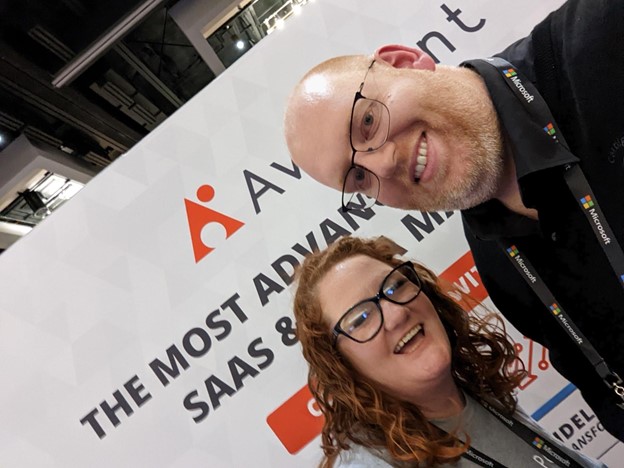For more AIIM Conference 2022 coverage, check out “Why Managing Integrity is Vital to Information Management.“
Tasked with engaging colleagues across the organization, records and information managers are confronted with varying (and sometimes conflicting) goals and priorities. This is particularly true when it comes to IT teams. While this relationship can sometimes be challenging, it’s also critical to achieving secure and effective information management in the modern workplace.
At this year’s AIIM conference, Alyssa Blackburn and I had the privilege of leading a roundtable session talking about this very issue. We asked participants to share common friction points, as well as strategies they’ve found to be useful. Here’s what we heard:
1. “We’re speaking two different languages.”
As a former IT person myself, I can attest that’s true. There is an inevitable language barrier based on each group’s training and expertise. Alyssa and I once wasted two hours on a discussion about “files.” A former records manager, she was referring to physical folders, whereas I was talking about Word documents, Excel spreadsheets, and so on. It’s critical to acknowledge that RIM and IT professionals are coming into a conversation with different perspectives, different areas of expertise, and different terminology. Only by being hyper-aware of this can we begin to address it.
Strategy:
Find points of overlap. Rather than saying, “Let’s chat about records management,” say “Can we discuss information governance? Information lifecycle?” Language is incredibly important, and this subtle shift in terminology is more likely to produce a more favorable response.
According to AIIM’s 2022 State of the Intelligent Information Management Industry report, 45 percent of organisations know where information silos are and are actively trying to reconcile them. With ramifications for both content and workspaces, perhaps that’s a good place to start the conversation.

2. “They just don’t get it.”
This is more accurate than I’d like to admit, if I’m being honest. From one-size-fits-all retention rules to unmanaged disposition, we heard many tales of frustrating, seemingly uninformed requests coming from the IT side of the office. “My IT team are saying we need to set retention on the Team, but they simply don’t understand the concept of retention based on content and context. ‘Can’t we just delete all Teams after 2 years?’” NO.
IT and Information Management have historically operated as two disparate teams with distinct areas of expertise. Unfortunately, Records and Information Management can also have a bad reputation for being disruptive as opposed to helpful. If there’s any hope of finding common ground, it’s the responsibility of both sides to understand at least the basics of what their counterparts are managing on a day-to-day basis.
Strategy:
One of the best pieces of advice we heard was to adopt a “What’s in it for me?” mindset. IT are far more likely to be engaged and responsive if they can see how the conversation or initiative benefits them. Try “I’d like to set up a meeting to talk about information security,” or “I know you’re focused on workspace governance. Can we talk about how to make the sure the content in those workspaces is managed?”
Thwart the information management stereotypes by framing conversations as, “Here’s how I can help” as opposed to “We shouldn’t be doing this” or “You need to stop doing that.” To quote Jerry Maguire, “Help me help you.”

3. Misaligned Titles or Reporting Structure
Many of our attendees reported that their organisation’s Records Management team (sometimes a team of one) sat within a seemingly random department, or had been moved around quite a bit. “We originally took over Records Management from Law, moved to Training, then Health & Safety, next Operations, and now IT. Four times in four years.” This type of departmental or reporting structure misalignment can often inadvertently devalue what the RIM team is bringing to the table.
Solution:
If at all possible, shifting your business unit area can often deliver more visibility and perceived value. One attendee reported that since Records & Information Management was shifted to “sit” within her company’s IT department, the level of collaboration on information governance has increased significantly. Sometimes, proximity is power.
Similarly, think about your job title and make sure it’s aligned with other areas in your organisation. Again, language matters. The role itself does not change, but by changing the way we talk about it, we can shift the perception and add value.

4. “My team is an island.”
Much of the conversation at our AIIM session referred to “us” and “them,” highlighting the divide between IM and IT. “People in IT forget about the ‘Information’ part of their title and focus only on the ‘Tech.’” Indeed, each of these departments often operate in silos. As technology evolves and collaboration tools proliferate, it’s more important than ever that IM and IT work closely together. Again, IT is governing the workspaces while IM is managing the content. Two sides of the same coin.
Strategy:
If you find yourself isolated from IT, one effective strategy can be finding a sponsor within your organization. Not necessarily someone in your direct line of reporting, this sponsor should be someone who has a good rapport with (or ideally, influence over) the IT team. According to AIIM’s report, only 11% say that Information Governance enjoys the full commitment and support of the organization and its executives.
If you are able to identify an internal sponsor, an easy ask is simply for them to include you on meetings or conversations, even if you start as a fly on the wall. Over time, you can build trust, develop relationships, and begin to demonstrate the value that IM can add.
There isn’t a quick fix for breaking barriers between IT and IM, however the value achieved when you do this is significant for both business areas–and more importantly, for the organisation as a whole.

